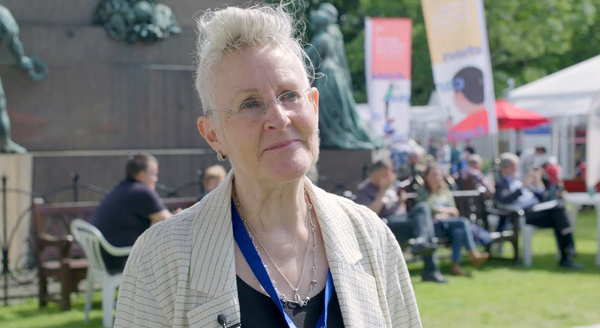This resource is great for:
Getting inspired by a top children’s author to write your own stories based on the people and places you know.
Summary:
Watch a filmed interview with children’s author Vivian French. Then use Vivian’s advice and the creative writing prompts below to create your own stories.
Download this resource:
Creative Writing with Vivian French – PDF
Creative Writing with Vivian French – Word doc
Introduction:
Vivian French is the author of fabulous books including The Tales from the Five Kingdoms, The Tiara Club, Sparkle Street and many more. Her latest book, The Cherry Pie Princess, tells the hilarious story of Princess Peony, who is everything a traditional princess isn’t meant to be! Vivian has worked as an actress, is a champion for illustrators, and currently lives in Edinburgh.
During the 2017 Edinburgh International Book Festival, we asked young reporter Megan to interview Vivian to find out about her new book, where she gets her ideas for stories and characters, and get her advice for young writers. Watch the video of the interview below and then read on for our fun activities to get your class writing their own stories.
Activities – Creative Writing Prompts
Part One
The character of Princess Peony in The Cherry Pie Princess was inspired partly by Vivian’s daughter, who was known at school for always standing up for people, and partly by her friend, who was very daring and brave at school. Vivian’s experience of libraries also inspired the setting for the book.
Are there people or places that you know that you could use in your story? Remember you can use different parts of them, keeping the features you want and leaving out the ones you don’t – it’s your story so you can decide what to chop and change!
Part Two
“I think it’s very important to stand up for the underdog, and to stand up for people who have been unfairly treated.”
Think of a situation where somebody needs help. It might be a serious situation or something silly.
Now think of a character who is least likely to be able to help them. Guess what? This is the character who’s going to help out in your story! (You could use the character that you thought of in part one.)
Use the following questions as prompts to write your story:
- What is the problem?
- Who is your main character with the problem?
- Who is the person least likely to be able to help them?
- How do they get involved and how do they try to help?
- Do they have an unexpected quality that lets them help?
- Does everything work out in the end, or do things go disastrously wrong?
Part Three
“Always start with a feeling. Who has it? Why do they have it? How are they going to feel at the end of the story? And then put the things together!”
Use Vivian’s advice above to write a simple story inspired by emotions. You’ll need to imagine how the character will feel and use lots of describing words to explain how and why they’re feeling this way. If their feelings are going to be different at the end of the story, you will need to think what is going to cause this change. Was it another character in the story, something that happened, or simply a change in the attitude of the character themselves?
This is a great way to use creative writing to help your class discuss emotions. It’s often easier for pupils to express their own feelings through an imaginary character than speaking about it from their own perspective. Talking through the emotions included in the stories could start a discussion around what causes pupils to feel upset, and what you can do (or who you can talk to) to feel better.
Remember the stories can be about someone feeling bad and then being helped to feel better, or it might be about something happening that causes the character feel bad. (Teacher tip: This could prompt a discussion on how it’s OK to feel bad sometimes and some of the things you can do to help yourself feel better.)
Part Four
“[Illustrations] give the book a depth and a magic and they help people’s imaginations.”
Vivian loves illustration and working with illustrators, and even teaches illustration at Edinburgh College of Art. Make sure you finish off your story by adding some beautiful (or perhaps silly!) illustrations.
Take a look at www.picturehooks.org.uk, a mentoring scheme for illustrators which Vivian helped to found, for inspiration.
Further information:
Young reporter Megan is taking part in What’s Your Story?, Scottish Book Trust’s development programme for teenage writers and illustrators. Find out more about the programme at www.thestoryis.co.uk
